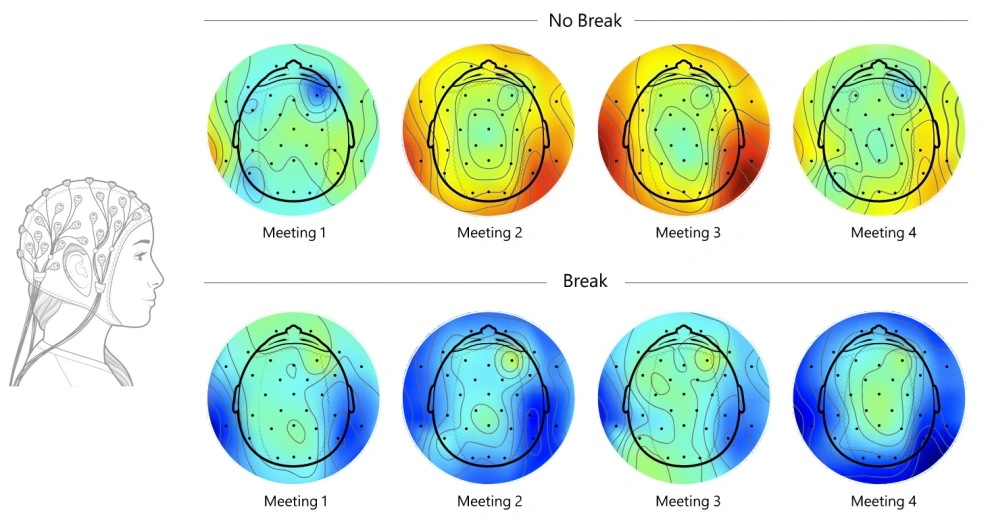When educational institutions switched to online classes during the pandemic, students thought they were taking an extended vacation from the stress of school and college.
Fast forward a few months and the reverse happened — many students were left more stressed than they were while attending offline classes.
Several studies also corroborated the negative impact Zoom classes had on students’ mental health and showed how they decreased productivity among students.
This article explains why this happens and how institutions can fix this serious problem.
How Zoom affects the brain
On the surface level, long Zoom classes seem harmless. After all, you’re only sitting at home doing nothing but listening and participating like you would in an offline class.
So, where is all the stress coming from?
Turns out that passively staring at a flat screen for extended periods has deeper consequences than we realize.
In the latest Microsoft study, 14 participants attended four 30-minute long meetings- one day with a 10-minute break and the other day without a break.
All test subjects wore an EEG cap that monitored their brain activity, and the results were unflattering.
When the participants attended back-to-back meetings without breaks, their beta wave activity increased, indicating higher levels of stress, anxiety, and concentration.
 Image source: Microsoft/Brown Bird design
Image source: Microsoft/Brown Bird design
While this study is more about employees in an online workplace, Zoom calls would have a similar effect on students since they attend lengthy classes without breaks.
But how can video calls cause such high levels of stress?
Let’s explore these reasons in detail in the following sections.
1. Cognitive Load
No matter how realistic video chats (VCs) look, they don’t beat in-person communication.
Our brains process real-time interactions easier than VCs because they don’t have to deal with distorted videos and low-quality, intermittent audio due to a spotty internet connection.
Yes, VCs transmit verbal and non-verbal cues in real time, but there’s a slight delay in transmission, which causes intense interpersonal communication issues.
For instance, even short delays of 1.2 seconds produce negative perceptions of individuals on VC, causing viewers to perceive them [the speaker] as less friendly or focused.
Although these differences appear minuscule, this lack of non-verbal responses (like a nod or a smile) and real-time replies hinder seamless communication.
Other reasons for the cognitive load and the resulting fatigue are that we’re not used to staring at screens for a long time and trying so hard to discern facial expressions.
For instance, you’ve got to maintain eye contact with the speaker and nod to show that you’re listening.
But this isn’t how we listen in an in-person classroom, so the intense eye contact feels unnatural and adds to the stress because of the proximity of the faces.
2. Hyper-awareness
If staring at others in an online Zoom class is unnatural, so is staring at yourself. You’re constantly scrutinizing your appearance because you feel the pressure to look good.

To add to this, students constantly feel the need to be responsive. Marissa Shuffler, an associate professor at Clemson University, explains this dread better.
She says, “When you’re on a video conference, you know everybody’s looking at you; you are on stage, so there comes the social pressure and feeling like you need to perform.”
Not only does this lead to mental and emotional exhaustion, but it also decreases your self-esteem because your brain is constantly getting feedback on your presentation.
3. Emotional distractions
While attending classes right from home might seem convenient, it can be distracting because of issues like poor connectivity and hardware glitches.
Also, in a traditional classroom setting, students compartmentalize home and school, and the two settings do not mix. However, Zoom classes almost invade their home life, and not everyone is comfortable with it.
Students allow their teachers and classmates a peek into their homes, seizing this personal space and causing emotional stress.
Further, there’s a misunderstanding that remote learning leaves room for other activities and free time. In reality, students end up multi-tasking, and teachers try to fill up the “free time” with extra homework.
And the adverse effects don’t stop there. Teaching and learning in an online setting are taking a toll on students, and we’ll dive deeper into why this happens in the next section.
Zoom classes are chipping away at students’ mental health.
“Online classes have had a negative effect on my mental health because my motivation and drive to do the work has diminished.
School used to be exciting, and I wanted to go to class with people and learn from a teacher in the front of the room, but with the nature of the online classes, my desire to partake in schooling has gone way down.”
-Joey Brown, Information sciences and Technology Major at Penn State University
Thousands of other students like Joey feel the same way, and here’s why.
Anxiety from lack of conceptual understanding
Online classes are different from offline ones, yet teachers use the same procedural teaching method for both modes.

The obvious outcome is that students are unable to grasp concepts well, which leads to undue stress and a drop in grades.
In fact, a study that The Research Institute and Academic Services, Assumption University (2021) conducted also supports this. It showed that more than 75% of the survey participants were stressed because:
- They couldn’t understand what was being taught.
- Some subjects couldn’t be taught in online classes. For example, highly-complex topics like quantum physics are understood better with videos rather than on whiteboards in online classes.
- They couldn’t focus during online classes.
Added stress for disabled and neurodiverse students.
‘Neurodiversity’ is a term used for non-pathological variations in the human brain that affect learning, mood, social functions, and other mental capacities. ADHD, autism, and dyslexia are some examples of neurodiversity.
Although online classes enabled these students to work in a familiar setting and control their sensory inputs, they also created problems.
Since ND students struggle to adjust to new routines and struggle with communication, the hyper-awareness and increased cognitive load made them feel worse.
Why Virtual Reality (VR) is the best alternative to Zoom classes
While VR learning is not a panacea for digital problems, it tackles several important issues. It transforms 2D classrooms into 3D environments, helps ND students with development, and overcomes several limitations of Zoom calls.

Improved Learning Experience
To begin with, Virtual Reality classrooms instantly enhance the learning experience. With just a headset, students can be with their teachers and classmates in a shared digital space.
As the VR classroom can emulate the real-world classroom, it mimics in-person interactions and creates a boundary between the classroom and a student’s home environment, lessening anxiety.
Plus, teachers can take students into a simulated environment to explain complex topics easily. For instance, students can get inside the human body to learn more about anatomy or take a trip back in time to learn history.
Educational institutions can go one step further and create a VR campus in the Metaverse to enhance the learning experience and ensure that students from anywhere get access to quality education.
Helps ND Students
VR enables ND students to control their sensory inputs like they would at home while helping them maintain a routine of interacting with people and getting the necessary therapy.
Further, they can access VR programs specifically developed to improve their communication. A good example is the VOISS (Virtual Reality for Opportunities to Integrate Social Skills).
This program walks students through day-to-day social situations by assigning problems they can solve through interactions.
Wrapping Up
While the Metaverse and VR education are still in their infancy, they’re potential solutions that can cut down problems caused by Zoom classes.
To begin with, educators can use various methods like virtual field trips, VR courses, and live experiments to make classes more engaging and improve conceptual understanding.
ND students can also benefit from it as it gives them access to their usual therapy sessions and helps them control their environment.
If you want to go one step further, you can also create a virtual campus in the Metaverse, which amplifies this effect. The possibilities are endless.



